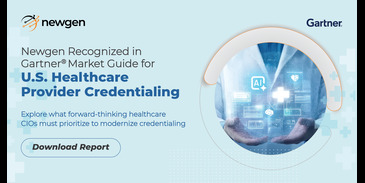In healthcare, data is not just a tool. It is the core of everything from compliance to care delivery. But as data volumes grow, the harder it gets to manage any of it without creating chaos. Traditional systems, built on layered workflows, fragmented platforms, and patchy integrations, struggle to keep up and scale effectively.
This is where artificial intelligence (AI) steps in, and it enters not just as a bolt-on automation tool, but as a foundational upgrade. AI enables real-time provider data verification, validation, compliance tracking, and structured access across every department that touches clinical or operational data. If health plans, like yours, are running into data mismatches, audit failures, or onboarding bottlenecks, this is where your fix begins.
More than a disruptive force, AI is changing the way provider data in healthcare is captured, processed, and managed. Studies suggest that by 2030, AI technologies might save 250,000 lives and remove up to 86% of healthcare employees’ errors.
What is AI-first Provider Data Management?
AI-first provider data management is an intelligence-layered system that continuously reviews, corrects, and updates provider information across all systems in real time. The system performs active license verification, credential flagging, automatic record updates, and the generation of structured audit logs with complete traceability.
The AI system uses machine learning models trained on large volumes of provider data. These models recognize common errors, spot outliers, detect expired credentials, and compare current records with licensure databases and HR systems. Natural language processing allows the system to work with free-text documents, including scanned credential forms, CVs, letters of recommendation, or uploaded PDFs from state boards. The unstructured files are parsed and converted into standardized, structured data fields ready for validation and tracking.
Why Do Health Plans Need AI for Provider Data Accuracy?
For health plans operating across multiple provider networks, one broken data point can lead to thousands of incorrect claims, missed eligibility verifications, and even compliance penalties. The issue isn’t a lack of concern about data quality. The real problem is that traditional systems simply cannot keep up with how quickly provider data evolves. Licenses expire, groups shift, and affiliations get reassigned.
Further, plans expand into new geographies with different credentialing rules. And such movement makes it impossible to rely on static data stored in outdated systems. That is exactly where AI addresses the gaps.
Here is why health plans cannot afford to manage provider data without AI:
- Provider rosters change daily, not quarterly, and AI is the best way to update them in real-time without burdening your internal teams with manual rework
- Credential mismatches between delegated entities and your central directory can derail audits. AI keeps everything in sync, instantly
- Without AI, tracking expirations, recredentialing cycles, and state-specific rules manually fall on your teams, increasing operational risks
- AI helps surface data issues early by flagging outdated records, duplicated entries, or inactive providers
- Every provider error that slips through costs time, money, and trust. AI catches them before they turn into financial and compliance penalties
Top Challenges in Legacy Provider Data Management
The problem with most legacy provider data systems is that they were not built for modern scale, volume, and accountability requirements. The systems were patched together to meet minimum compliance, but they fail when managing over a few hundred providers or information across multiple departments and systems.
- Manual Entry Breaks the Whole Chain
In hospitals, health systems, and payer networks, the same provider record gets logged into five or six different platforms: HR, EHR, credentialing, billing, scheduling, and every single one is managed manually. One mistake in a license number or a missed update in one system can mark an eligible provider as ineligible, or worse, keep billing under credentials that are no longer valid
- No Single Source of Truth for the Provider
Different departments hold specific pieces of the provider profile: HR has the employment record, credentialing has the board info, scheduling knows where they work, billing has their payer contracts, but none of it syncs. You are stuck reconciling incomplete snapshots from disconnected platforms, and the whole picture never shows up unless someone builds it by hand. Practically, this approach does not scale in any health system
- Compliance Misses Start Small but End Costly
Without constant validation, licenses expire, board certifications lapse, and training records go stale. No one catches it until someone runs a report or gets flagged in an audit. And by that point, it is too late. Claims have gone out, care has been delivered, and now you are holding a stack of corrections, penalties, and sometimes a regulatory escalation you could have avoided with real-time checks
- Non-adherence to Changing Regulations
The rules change constantly as new state requirements, board policy shifts, and payer contract updates arise. Traditional systems struggle because they are static by design, unless manually updated. Workflows keep running with outdated logic, provider files drift out of compliance, and your teams keep putting out fires that should not have been lit in the first place
Benefits of AI-first Provider Data Management Solution for Health Plans
For leading health plans, bad provider data costs money every single day. It slows claims, delays onboarding, and breaks compliance. The enlisted five benefits are what AI systems are actually delivering today if built right.
- Keeps Hospital Networks Aligned with Real-time Provider Data
AI platforms constantly update and validate key provider details across EHRs, credentialing systems, scheduling tools, and billing platforms so everyone is working off the same version of the truth. Updates include license status, specialty codes, NPI, practice locations, and affiliation structures, all handled without manual syncing
- Reduces Manual Compliance in Provider Data Management
With AI, the platform automatically keeps track of license expirations, board certifications renewals, and shifting regulations. Every update is logged with time, user, and action history. The audit trail is not scattered across email chains and old credentialing folders
- Ensures Faster Onboarding for Healthcare Providers with AI Credentialing Pipelines
Onboarding new physicians or advanced practice providers into your organization should not be held up by credentialing cycles that still rely on email attachments and hand-filled checklists. AI systems can connect to live licensure databases, national board registries, and NPI lookup services to pull the provider’s core credentials into your system in minutes instead of days. When there is a mismatch, a gap, or a missing piece, the system flags it early and routes it directly to the responsible person for resolution.
- Maintains Cleaner Claims with Accurate Provider Data
Revenue cycle teams in hospitals spend an unreasonable amount of time fixing problems caused by incorrect provider data that should have been caught upstream. Whether it is an expired license, a mismatched group NPI, or a taxonomy that no longer fits the provider’s actual practice, the result is always the same: delayed claims, rework, and financial leakage.
AI platforms help prevent errors by validating credential data before it ever touches the billing system. The provider record is checked in real time for active status, correct codes, and valid affiliations, so billing teams are not left patching errors they did not create
- Tracks Delegated Credentialing Risk in Multi-entity Healthcare Networks
When credentialing is delegated across multiple hospitals, affiliates, or outsourced vendors, the risk of missed deadlines or outdated records grows fast and quietly. These gaps do not usually show up until a recredentialing deadline is missed, or an audit flags missing documentation long after care was delivered.
AI tracks the full update activity across every provider record, tracking which groups are late, inconsistent, or skipping required steps altogether. Instead of quarterly reports that come too late, the system shows you in real time where things are slipping so you can correct it before it turns into a compliance issue
Future Trends in AI and Provider Data
As AI embeds deeper into healthcare infrastructure, provider data systems will move far beyond cleanup and automation. What lies ahead is not just faster dashboards. The future of data management is moving towards foundational shifts in how provider identity, licensure, performance, and eligibility get tracked and used across systems.
- Autonomous Credential Lifecycle Management
Right now, credentialing still needs a team to initiate updates, validate documents, and manage reappointments. AI will move from a monitoring role to an initiating one. It will not wait for admins to send reminders. The system will auto-initiate recredentialing workflows based on time cycles, rule updates, and provider activity. Documents will be pulled, flagged, validated, and routed without any manual setup. Entire cycles will run on their own unless human oversight is triggered by exception.
- Federated Provider Identity Graphs
One of the biggest unsolved problems is duplication and mismatch across systems. Future systems will build what is essentially a federated identity graph, a centralized, continuously updated provider fingerprint that links identities across every system and entity. This will not rely on a single source of truth. It will be distributed, with AI agents mapping identity signatures across EHRs, credentialing systems, and payer portals. The system will resolve inconsistencies automatically using context weight, timestamp logic, and verification scoring.
- Embedded AI at Point-of-Care Integration
Provider data will no longer live inside credentialing platforms. Future trends are heading toward embedding AI provider data agents directly into clinical tools. Think of EHR-integrated agents that auto-confirm in real time if the attending physician is actively licensed, DEA certified, and covered for the procedure being performed. The system will not ask the clinician. It will just run the check in the background and send alerts if anything looks off. The validation creates a silent safety net right at the point of care.
- Multi-jurisdictional Regulatory Engines
As more providers work across regions and via virtual platforms, the regulatory complexity is scaling fast. AI systems will evolve to include multi-jurisdictional regulatory logic engines. These engines will map role-based requirements across all relevant states, boards, and specialty organizations. The platform will automatically adjust credential workflows depending on where and how the provider practices, even if that changes mid-contract.
- Provider Performance-linked Data Scoring
AI will start linking credential data to provider outcomes readmission rates, treatment adherence, peer review flags to generate performance-weighted provider profiles. These profiles will highlight if the provider is trending toward underperformance based on historical markers. Health systems will use this for proactive coaching, targeted retraining, or even contracting decisions.
Choosing the Right AI-first Provider Data Platform
Before you pick a provider data platform, evaluate the following critically.
- Data Model Transparency: Can the vendor explain how their models make decisions, and can those decisions be audited?
- Live Data Integration: Is the platform pulling real-time updates from licensure databases, credentialing boards, and regulatory feeds?
- Scalability: Will the system still perform when managing data for 5,000 providers or 50,000? Ask for real deployment examples.
- Vendor Collaboration: Are implementation teams available? Will they support integration with your systems and train your teams properly?
- Compliance Fit: Can the system enforce your policies, map to your regions, and adapt to your regulatory frameworks?
Where Health Plans Go from Here
Today, provider data management is the front line of compliance, billing, onboarding, and care coordination. Yet, many health plans still rely on spreadsheets or disconnected tools. Manual approaches are not only inefficient but also risky when they delay provider onboarding, cause billing denials, or trigger compliance investigations.
Infusing AI does not just improve the process. It replaces the parts that fail under pressure with systems that adapt, learn, and respond. AI systems have already been proven to reduce credentialing time, increase data accuracy, and help providers avoid compliance issues.
For organizations looking to modernize provider data management without tearing down its existing workflows, platforms like Newgen offer the right blend of intelligence, scalability, and enterprise integration. These are not theoretical solutions. They are already in use, solving real problems, and helping healthcare systems operate with the accuracy and speed modern care demands.
You might be interested in


29 May, 2025
Bridging the Information Gap: Enhancing Healthcare Delivery Through Intelligent ECM


